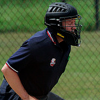Oddest / Most Unique Ground Rule?
Umpire-Empire locks topics which have not been active in the last year. The thread you are viewing hasn't been active in 2931 days so you will not be able to post. We do recommend you starting a new topic to find out what's new in the world of umpiring.
-
Similar Content
-
- 11 replies
- 1,980 views
-
- 12 replies
- 1,688 views
-
A little further back from the catcher than usual...
By TheGeneral,
- college
- developmental
- (and 2 more)
- 6 replies
- 1,304 views
-
- 1 reply
- 1,286 views
-






Recommended Posts